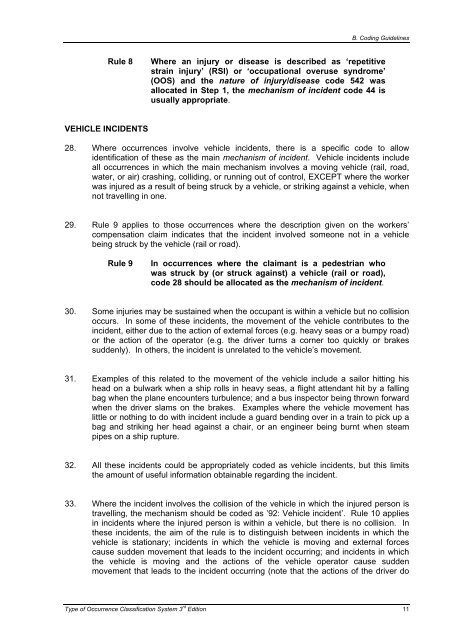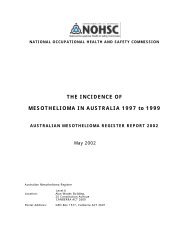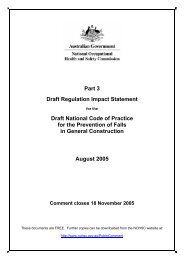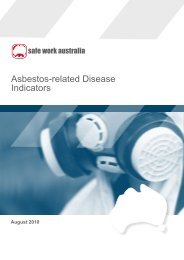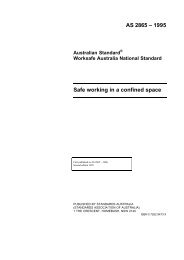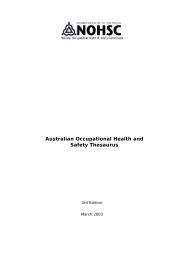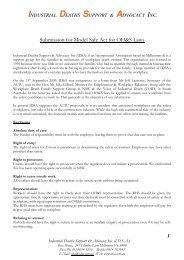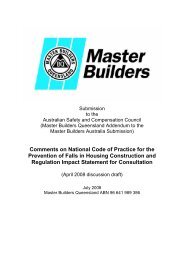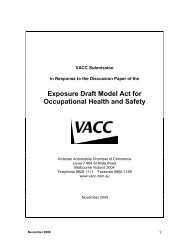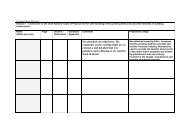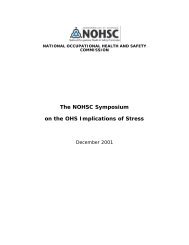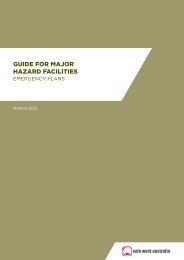Type of Occurrence Classification System - Safe Work Australia
Type of Occurrence Classification System - Safe Work Australia
Type of Occurrence Classification System - Safe Work Australia
You also want an ePaper? Increase the reach of your titles
YUMPU automatically turns print PDFs into web optimized ePapers that Google loves.
B. Coding GuidelinesRule 8Where an injury or disease is described as ‘repetitivestrain injury’ (RSI) or ‘occupational overuse syndrome’(OOS) and the nature <strong>of</strong> injury/disease code 542 wasallocated in Step 1, the mechanism <strong>of</strong> incident code 44 isusually appropriate.VEHICLE INCIDENTS28. Where occurrences involve vehicle incidents, there is a specific code to allowidentification <strong>of</strong> these as the main mechanism <strong>of</strong> incident. Vehicle incidents includeall occurrences in which the main mechanism involves a moving vehicle (rail, road,water, or air) crashing, colliding, or running out <strong>of</strong> control, EXCEPT where the workerwas injured as a result <strong>of</strong> being struck by a vehicle, or striking against a vehicle, whennot travelling in one.29. Rule 9 applies to those occurrences where the description given on the workers’compensation claim indicates that the incident involved someone not in a vehiclebeing struck by the vehicle (rail or road).Rule 9In occurrences where the claimant is a pedestrian whowas struck by (or struck against) a vehicle (rail or road),code 28 should be allocated as the mechanism <strong>of</strong> incident.30. Some injuries may be sustained when the occupant is within a vehicle but no collisionoccurs. In some <strong>of</strong> these incidents, the movement <strong>of</strong> the vehicle contributes to theincident, either due to the action <strong>of</strong> external forces (e.g. heavy seas or a bumpy road)or the action <strong>of</strong> the operator (e.g. the driver turns a corner too quickly or brakessuddenly). In others, the incident is unrelated to the vehicle’s movement.31. Examples <strong>of</strong> this related to the movement <strong>of</strong> the vehicle include a sailor hitting hishead on a bulwark when a ship rolls in heavy seas, a flight attendant hit by a fallingbag when the plane encounters turbulence; and a bus inspector being thrown forwardwhen the driver slams on the brakes. Examples where the vehicle movement haslittle or nothing to do with incident include a guard bending over in a train to pick up abag and striking her head against a chair, or an engineer being burnt when steampipes on a ship rupture.32. All these incidents could be appropriately coded as vehicle incidents, but this limitsthe amount <strong>of</strong> useful information obtainable regarding the incident.33. Where the incident involves the collision <strong>of</strong> the vehicle in which the injured person istravelling, the mechanism should be coded as ’92: Vehicle incident’. Rule 10 appliesin incidents where the injured person is within a vehicle, but there is no collision. Inthese incidents, the aim <strong>of</strong> the rule is to distinguish between incidents in which thevehicle is stationary; incidents in which the vehicle is moving and external forcescause sudden movement that leads to the incident occurring; and incidents in whichthe vehicle is moving and the actions <strong>of</strong> the vehicle operator cause suddenmovement that leads to the incident occurring (note that the actions <strong>of</strong> the driver do<strong>Type</strong> <strong>of</strong> <strong>Occurrence</strong> <strong>Classification</strong> <strong>System</strong> 3 rd Edition 11


